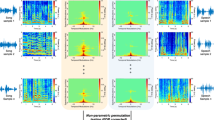Abstract
The amplitude-temporal and spectral characteristics of the short-latency auditory evoked potentials (SLAEP) recorded under conditions of monoaural stimulation with sound clicks with initial phase of rarefaction followed by compression and alteration, with the intensity of 60 dB and frequency of 11.1 Hz, were studied in ipsi- and contralateral derivations. Substantial changes in SLAEP morphology in response to polarity inversion of the acoustic stimulus were found. Waves II, IV, VI, and VII changed to the greatest extent. The spectral analysis detected three main SLAEP components: low- (LF), medium- (MF), and high-frequency (HF) components as well as the respective frequency bands. Change in the click phase from rarefaction to compression resulted in bilateral redistribution of power between the MF and HF components. This was expressed as a decrease in the HF peak power and simultaneous rise of MF power. Selective effects of the polarity inversion of the sound stimulus on the MF and HF components support the finding that the activity of SLAEP-generating structures are mainly reflected in the mentioned components. It is suggested that two populations of phase-sensitive units are represented in the auditory analyzer. These populations determine the characteristic changes in SLAEP morphology and spectral characteristics.
Similar content being viewed by others
References
Jewett, D.L. and Williston, J.S., Auditory Evoked Far-Fields Averaged from the Scalp of Humans,Brain, 1971, vol. 94, p. 681.
Khechinashvili, S.N. and Kevanishvili, Z.Sh.,Slukhovye vyzvannye potentsialy cheloveka (Auditory Evoked Potentials of a Human), Tbilisi: Sabchota Sakartvelo, 1985.
Ogleznev, K.Ya., Shestrikov, S.A., and Shubin, E.B.,Vyzvannye potentsialy stvola mozga i perifericheskikh nervov (Evoked Potentials of the Brain Stem and Peripheral Nerves), Novosibirsk: Nauka, 1987.
Schwartz, D.M., Morris, M.D., Spydell, J.D.,et al., Influence of Click Polarity in the Brain-Stem Auditory Evoked Response (BAEP) Revisited,Electroencephalogr. Clin. Neurophysiol., 1990, vol. 77, no. 6, p. 445.
Ornitz, E.M. and Walter, D.O., The Effect of Sound Pressure Waveform on Human Brain-Stem Auditory Evoked Responses,Brain Res., 1975, vol. 95, p. 490.
Peake, W.T. and Kiang, N., Cochlear Responses to Condensation and Rarefaction Clicks,Biophys. J., 1962, vol. 2, p. 23.
Rosenhamer, H.S., Lindstrom, B., and Lundborg, T., On the Use of Click-Evoked Electric Brainstem Responses in Audiological Diagnosis. I. The Variability of the Normal Responses,Scand. Audiol., 1978, vol. 7, p. 193.
Stockard, J.E., Stockard, J.J., Westmoreland, B.F., and Corfits, J.L., Brainstem Auditory Evoked Responses. Normal Variation as a Function of Stimulus and Subject Characteristics,Arch. Neurol., 1979, vol. 36, p. 823.
Stockard, J.J., Stockard, J.E., and Sharbrough, F.W., Nonpathological Factors Influencing Brainstem Auditory Evoked Potentials. Part I,Amer. J. EEG Technology, 1978, vol. 18, p. 177.
Stockard, J.J., Stockard, J.E., and Sharbrough, F.W., Nonpathological Factors Influencing Brainstem Auditory Evoked Potentials. Part II,Amer. J. EEG Technology, 1978, vol. 18, p. 186.
Author information
Authors and Affiliations
Rights and permissions
About this article
Cite this article
Khachunts, A.S., Vaganyan, L.G., Bagdasaryan, R.A. et al. Short-latency auditory evoked potentials during change in the physical parameter of a sound stimulus. Hum Physiol 26, 290–295 (2000). https://doi.org/10.1007/BF02760189
Received:
Issue Date:
DOI: https://doi.org/10.1007/BF02760189




